MXA RACE TEST: THE REAL TEST OF THE 2021 KTM 450SXF
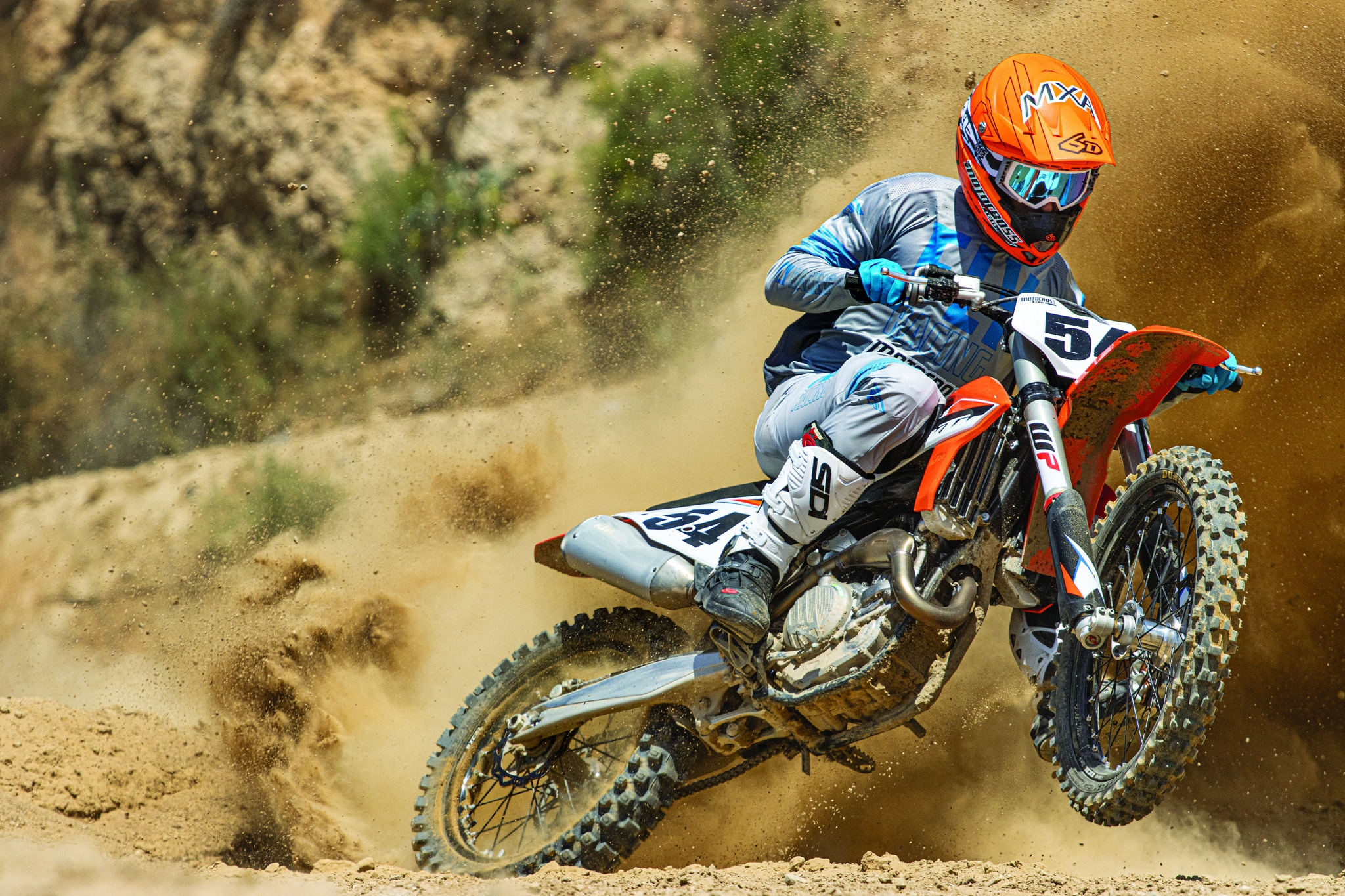
Q: FIRST AND FOREMOST, IS THE 2021 KTM 450SXF BETTER THAN THE 2020 450SXF?
A: Yes, but it should be noted that very few, if any, of the changes are visible to the naked eye. They are either electrical or internal.
Q: WHAT IS THE BIGGEST AND MOST SIGNIFICANT CHANGE TO THE 2021 KTM 450SXF?
A: There is no use in talking about all the other aspects of the 2021 KTM 450SXF without delving deep into the all-new, revised, refined and reworked WP XACT air forks first. So, let’s get started.
(1) The goal. For 2021, KTM wanted to build an air fork that delivered the feel of a coil-spring fork while maintaining the 3-pound weight advantage, infinite adjustability and tune-ability of an air fork. Yes, Showa and Kayaba failed miserably with the SFF and PS-F air forks five years ago, but WP had the advantage of learning from the mistakes that Showa, Kayaba and even WP itself made over the last half decade.
(2) Oil bypass notches. Oil bypass notches were machined into the forks to reduce oil pressure peaks when the stanchion bushing and cartridge bushing get close enough together to compress the fork oil. The oil bypass notches in the forks allow the oil to escape. The result is a more fluid feel in the second half of the fork’s stroke.

(3) Air seal. Since the oil bypass notches relieved oil-pressure buildup in the damping leg, WP decided to do the same thing on its air pressure leg. WP put four bypass holes in the air seal to lessen air pressure spikes. The holes allow excess air pressure to bleed off to make the forks resist the J-curve air pressure spike.
(4) Trampoline valve. Unlike on a traditional mid-valve shim stack, WP added a “trampoline shim,” so called because, unlike a normal shim that is tightly packed in by other shims and pistons, the trampoline shim has room to bend. The trampoline valve lessens the mid-stroke spike when the shim stack is over-pressurized.
(5) Negative chamber. When an air fork’s air is compressed, it builds up pressure at the top of the fork’s inner cavity. At full travel, this built-up pressure forces the fork to react in the opposite direction and extend the forks back to full length way too fast. This is called “topping out.” The best way to prevent topping out is a negative air chamber that holds enough air pressure to resist the fork’s tendency to top out. Showa and Kayaba tried to do this with separate air chambers, but their anti-top-out system was needlessly complex. The WP engineers invented a way to use the fork’s existing compression stroke air pressure on the rebound stroke to stop topping out. A cross-over bleed slot near the end of the compression stroke allows the pumped-up air pressure to leak into the rebound side of the fork to resist downward acceleration of the fork tubes. It is an ingeniously simple idea.
(6) Bottoming bump stop. The previous bottoming cone has been replaced with a bump-stop rubber on the 2021 fork. This lets the damping and air pressure provide control and the rubber bump to stop clanking.
(7) Rebound adjuster. Switching to the bump-stop rubber freed up enough room for WP to put in a rebound clicker that can be turned by hand without having to get down on your knees with a screwdriver.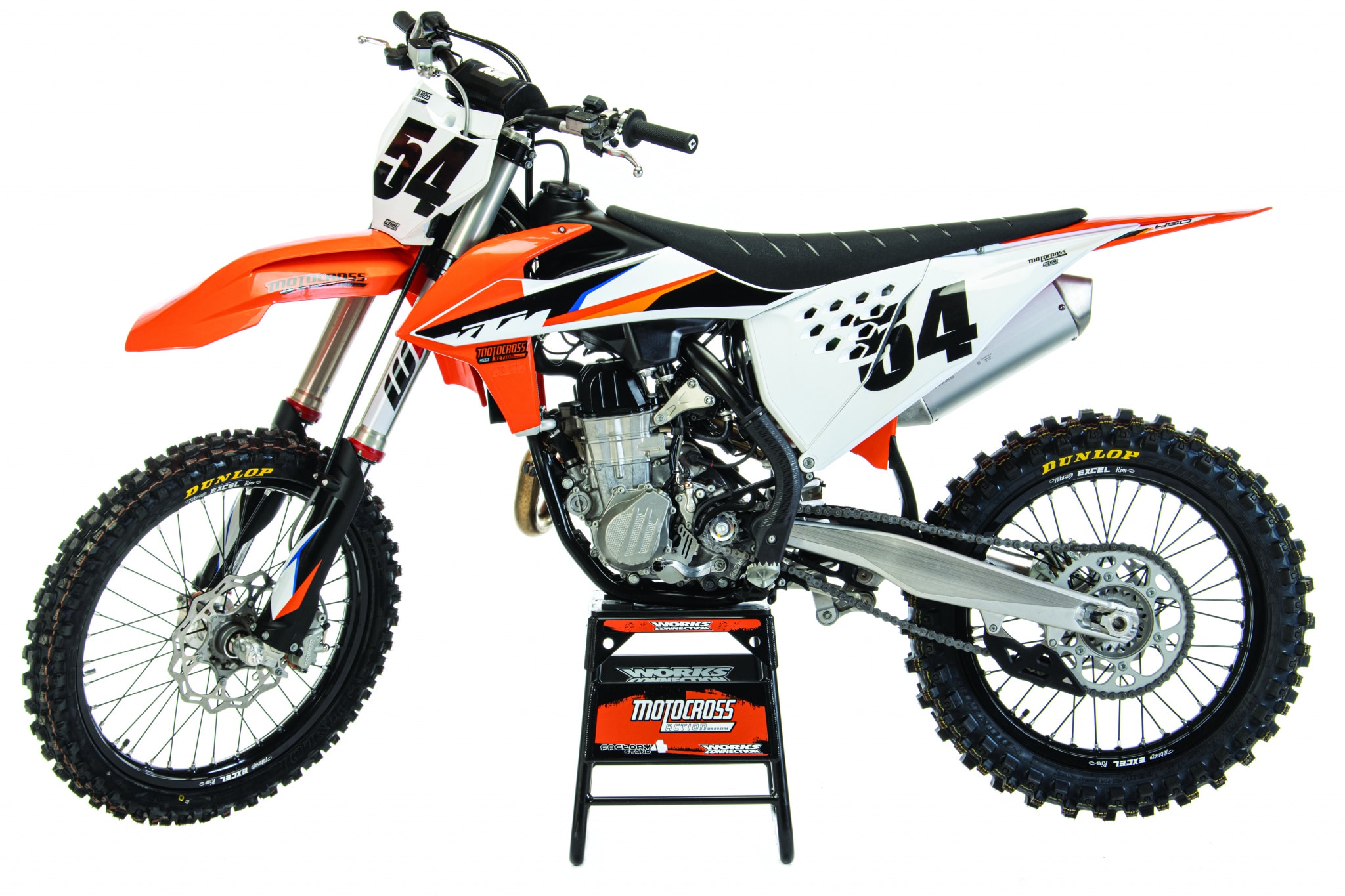 If you are looking for the lightest 450 with the strongest brakes, most reliable clutch, braided-steel brake lines, Pankl transmission, no-tools airbox and the engine profile that Honda copied in 2021, then this is it.
If you are looking for the lightest 450 with the strongest brakes, most reliable clutch, braided-steel brake lines, Pankl transmission, no-tools airbox and the engine profile that Honda copied in 2021, then this is it.
Q: WHAT IS THE DOWNSIDE OF THE WP XACT AIR FORK?
A: The rider has to be smarter than the fork. The burden of understanding how air pressure works in the role of a spring means finding your perfect air pressure, which doubles as the coil spring on an air-only fork. Once you find your personal air pressure, easily done with a zip-tie on the fork leg, all damping changes are done with the compression and rebound clickers. To make this work as well as possible, which means as well as Kayaba SSS forks, you have to become a master of the air pump. Once you learn how air pressure works, how it changes with the ambient temperature, and how to keep ahead of the curve, you will love these forks.
Q: HOW DO THE NEW 2021 KTM 450SXF XACT AIR FORKS WORK?
A: WP’s take on air forks is so different from Showa’s and Kayaba’s concept that they are not comparable. The ultimate goal of any air fork is to maximize its advantages over coil-spring forks without encouraging any of the negatives. All the 2021 KTM mods were designed to make the stroke more fluid, reduce air pressure spikes, bleed off excess oil pressure and reduce the effects of an air fork’s hyper-progressive spring rate at the end of the stroke. Every MXA test rider loved the new WP air forks. The front tire followed the ground like coil-spring forks, without any of the lift-off common with air forks. The complete stroke was smoother, delivered more feedback, and felt suppler. We know that there are lots of unhappy WP air fork owners out there, but for 2021, KTM focused its complete R&D program on addressing all the complaints about its WP XACT air forks.
Faster MXA Pro test riders ran the recommended 10.6 bar (154 psi) or higher. Intermediates ran 10.3 bar (150 psi). Fast Novices ran 10.0 bar (145). Novices and Vets ran 9.6 bar (140 psi). There were test riders who ran over 11.0 bar and riders who ran under 9.6 bar. KTM used to insist that its recommended air pressure was the best, but now KTM knows that the big plus of air forks is giving the rider the freedom to go as low or high as he wants.
Q: WHAT DID KTM DO TO THE 2021 450SXF MAPPING?
A: KTM put some effort into refining its previous maps for 2021. Most MXA test riders didn’t believe that there was a big enough difference between the mellow map and the aggressive map in previous years. They wanted more oomph from the mellow map (Map 1) and a lot more oomph from the aggressive map (Map 2). And that is what KTM did. The mellow map is a little more lively and a little crisper; however, Map 2 is considerably crisper and more responsive. Best of all, it is easy to tell the difference between Map 1 and Map 2.
If you want more power and quicker rev, send your black box to Twisted Development and have them put their map in place of the stock Map 2. You can reach Twisted Development at www.td-racing.com or by calling (951) 698-7222.
Q: IS THERE A TRICK TO USING KTM’S MAPS?
A: Not so much a trick as a performance option. Most MXA test riders, not necessarily the Pro test riders, combine Map 1 or Map 2 with traction control (TC). And they don’t just do it on rock-hard dirt where wheel spin is a certainty. They do it on a variety of terrain, often half soft and half hard, to maximize those sketchy moments when the rear end steps out, churns in a deep berm or skitters across braking bumps. It helps immensely in soft corners that exit onto a shiny patch of blue groove. Try it.
Q: IS THE VENTED AIRBOX COVER REALLY WORTH THE TROUBLE?
A: Yes. Consider the vented 2021 airbox cover an easily accessed tuning option. Most MXA test riders run the vented cover all the time, but if they find themselves on a super-slick track or in a sudden downpour, they don’t waste time with the non-vented OEM cover. Instead, they tape the vent holes over with duct tape. The vented airbox cover produces a noticeable increase in throttle response and rate of acceleration in the midrange. It is also worth 1 horsepower at high rpm.

Q: DID MXA CHANGE THE KTM 450SXF GEARING?
A: Yes, we did, but not in the way you think. Prior to the 2020 model year, the 450SXF came with a 48-tooth rear sprocket. In the search for more responsive acceleration and a quicker-revving low-to-mid powerband, the MXA wrecking crew always geared the 450SXF down one tooth by running a larger 49-tooth-cog rear sprocket. KTM paid attention and last year put a 49-tooth sprocket on as the OEM fitment. It was a good move that perked up the low-end power and made it easier to use third gear in many of the previous second-gear situations.
Q: WHAT ARE THE MECHANICAL CHANGES TO THE 2021 450SXF ENGINE?
A: There are none for 2021. Why not? Because in 2020, KTM changed the connecting rod, top-end rod bushing, rocker-arm balance and rigidity and reshaped, hard-coated and cammed the piston.
(1) Connecting rod. Made by Pankl, the connecting rod has replaced the coated top-end rod bushing with a true-to-life bronze bushing. KTM switched to bushings instead of bearings at both ends of the connecting rod several years ago.
(2) Rocker-arm topology. The KTM 450SXF rocker arm’s architecture has been redesigned to reduce inertia on the intake and exhaust valves. This isn’t just a simple matter of moving material around on the rocker arms but using computer analysis to maximize rigidity, reduce overall weight and decrease the polar moments of inertia.
(3) Piston. The box-shaped reinforcements under the piston’s dome have been beefed up, while the ring grooves are CNC-machined and hard-anodized. But, the most important upgrade on the CP piston was that it was cammed to fit perfectly against the bore. A piston’s cam is the difference in the width of the piston at its crown and the width at the bottom of the skirt. In 2020, KTM ground the skirts to remove 0.01mm of the aluminum’s thickness. Removing this tiny amount of piston-skirt width allowed the piston to expand under high temperatures, without excessive sidewall thrust.
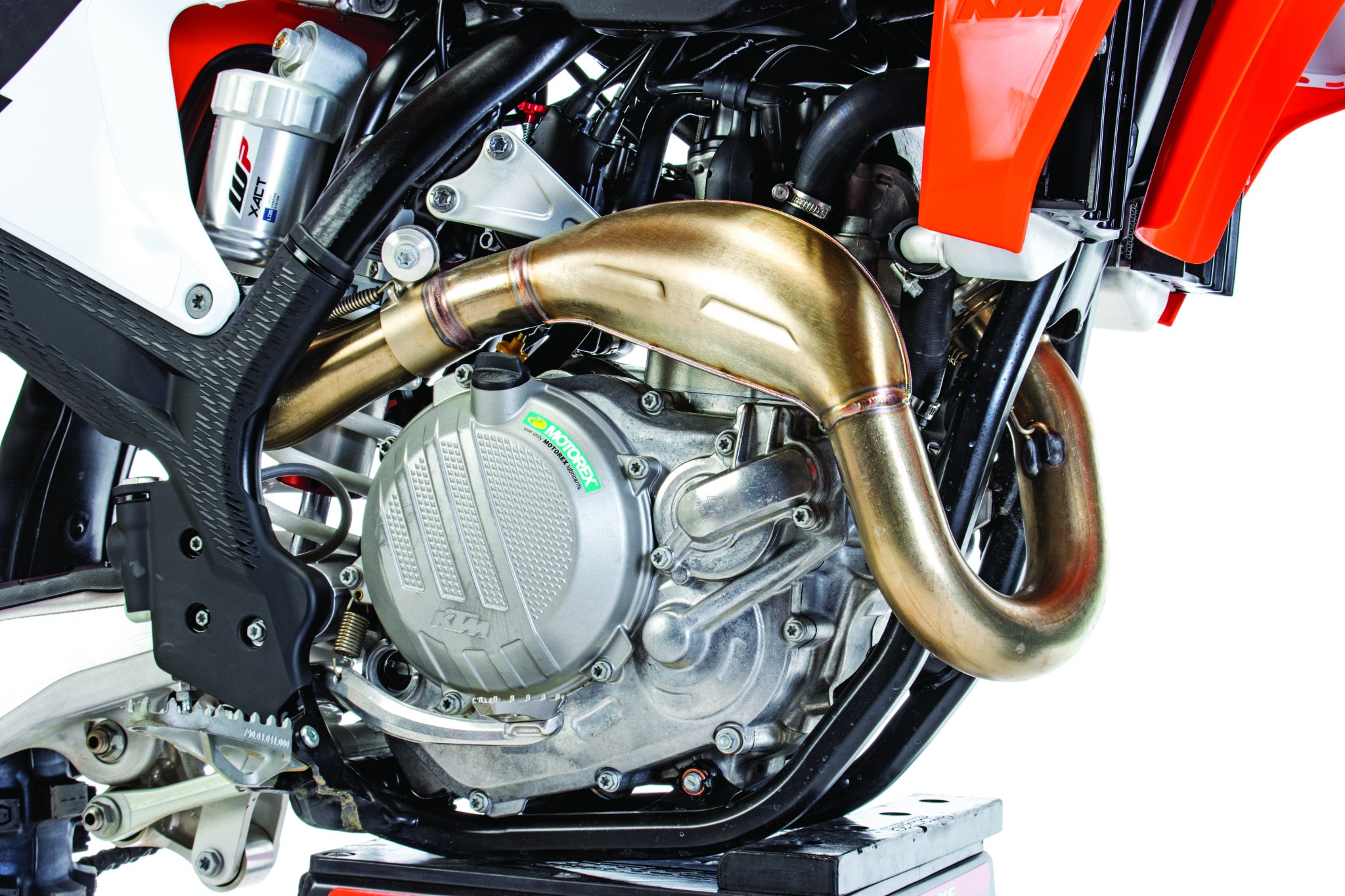
Q: AFTER ALL THESE CHANGES, HOW DOES THE 2021 KTM 450SXF RUN?
A: The power delivery is livelier, quicker and less draggy. We have to give kudos to the KTM R&D department. Even if they didn’t give us the American map, they listened to the American consumer and gave them what they wanted, which was stronger, quicker and more aggressive low to mid. Best of all, KTM managed to do this without losing the supremely usable transition of power that made the 450SXF so easy to ride.
KTM’s 2021 powerband, solely a product of revised mapping, gets to the meat of the powerband quicker. Best of all, KTM didn’t damage the metered, controlled and crescendo-style of power that the KTM is famous for. This is a different kind of power. It doesn’t blast power as much as it oozes it. You can use as much as you want or as little as you need. Luckily, a rider who wants less of a rush from low-to mid can easily switch to Map 1 and put the 48-tooth 2019 rear sprocket back on.
KTM is obviously doing something right with its powerband, because the 2021 CRF450 is a clone of the KTM 450SXF’s broad, linear style of power. That is saying a lot, because the red bike has been a fire-breathing horsepower dragon for the last three years. Imitation is the sincerest form of flattery

Q: HOW DOES THE 2021 KTM 450SXF HANDLE?
A: Have you ever driven down your favorite mountain road in a Toyota pick-up truck at full tilt and then, a day later, navigated the same road in a Porsche? The big difference isn’t just in G-forces, it’s also in your brain. The Porsche makes you feel like an F1 driver at the Nurburgring; the Toyota makes you feel like the schnitzel delivery driver going to the concession stand at Nurburgring. Just as with the Porsche, with the 2021 KTM 450SXF, your brain tells you that you can do anything you want. The KTM is the best all-around-handling bike on the track (and the KTM chassis comes in orange, white and red versions). There are bikes that turn sharper, but they shake, push or get loose on corner exit. The chromoly KTM chassis’ torsional stiffness pays dividends in overall accuracy. 
Q: WHAT’S SO GREAT ABOUT THE KTM 450SXF?
A: If you need a list, you must not have been paying close attention over the last decade.
(1) Brembo hydraulic clutch. This clutch is bulletproof. From its CNC-machined steel basket (with the primary gear machined into the basket) to its Belleville washer (instead of six separate coil springs) to its rubber-suspended cush inner hub to its self-adjusting Brembo hydraulics, no clutch on the track can take the kind of abuse that KTM’s can. This is the dream clutch of every clutch abuser in America.
(2) Pankl transmission. No other motocross brand offers a transmission built by a Formula 1 gearbox supplier. The 2021 KTM 450SXF comes with complete Pankl gear sets. The metallurgy is a step above what other brands offer.
(3) Brembo brakes. The “Big Four” Japanese brands have been throwing on 270mm rotors, new brake pads and calipers to try to keep KTM’s Brembo brakes in sight. They are still behind the curve.
(4) Braided steel brake hose. The KTM comes stock with a brake hose that has a minimal expansion PTFE hose with a 64-strand braided steel overlay.
(5) Electric starting. KTM has had electric starting on the 450SXF since 2007. You might be thinking, “So what? Almost every other 450 has electric starting also?” Yes, they do, but KTM knows how to do it without adding 5 pounds of extra weight.
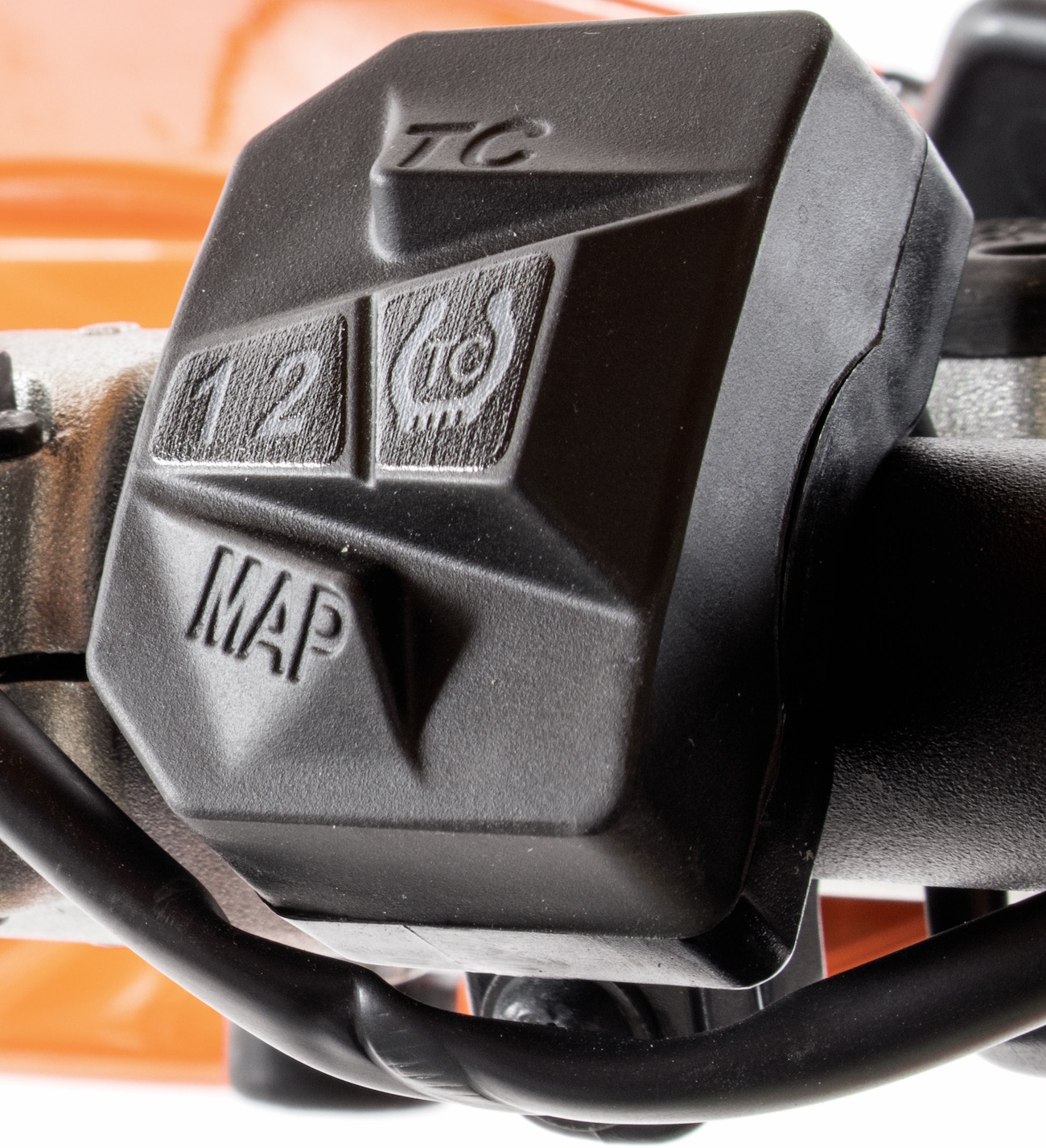 (6) Electronic suite. The 2021 KTM 450 has push-button accessed traction control, launch control and two maps. KTM does have a WiFi tuner, much like the Yamaha GYTR tuner, but it doesn’t come stock with the KTM; it is an option.
(6) Electronic suite. The 2021 KTM 450 has push-button accessed traction control, launch control and two maps. KTM does have a WiFi tuner, much like the Yamaha GYTR tuner, but it doesn’t come stock with the KTM; it is an option.
(7) Weight. At 223 pounds, the 2021 KTM 450SXF is 10 pounds lighter than the 2021 CRF450, 11 pounds lighter than the 2021 KX450, 15 pounds lighter than the YZ450F and 18 pounds lighter than the RM-Z450. You may think that weight doesn’t matter, but a bike’s rims, spokes, frame, shock spring, brakes and acceleration are weight-sensitive.
(8) Throttle cam. Your KTM sat on the showroom floor with the stock, long-throw, gray throttle cam installed. Take it out and put on the quick-turn black throttle cam that came as an option.
(9) Twin Air filter. If you’ve never installed an air filter into a KTM or Husqvarna, you will be amazed at how foolproof it is compared to the normal gymnastics of other air filter/cage/airbox designs.
(10) Hour meter. Kudos to KTM for putting an hour meter on its bikes as standard equipment.
(11) ODI grips. We like the ODI lock-on grips, because if we crash and rip the grip, we can put a new ODI grip on without having to wait for the glue to dry. If you want cushier grips, go with the glue-on ODI grips.
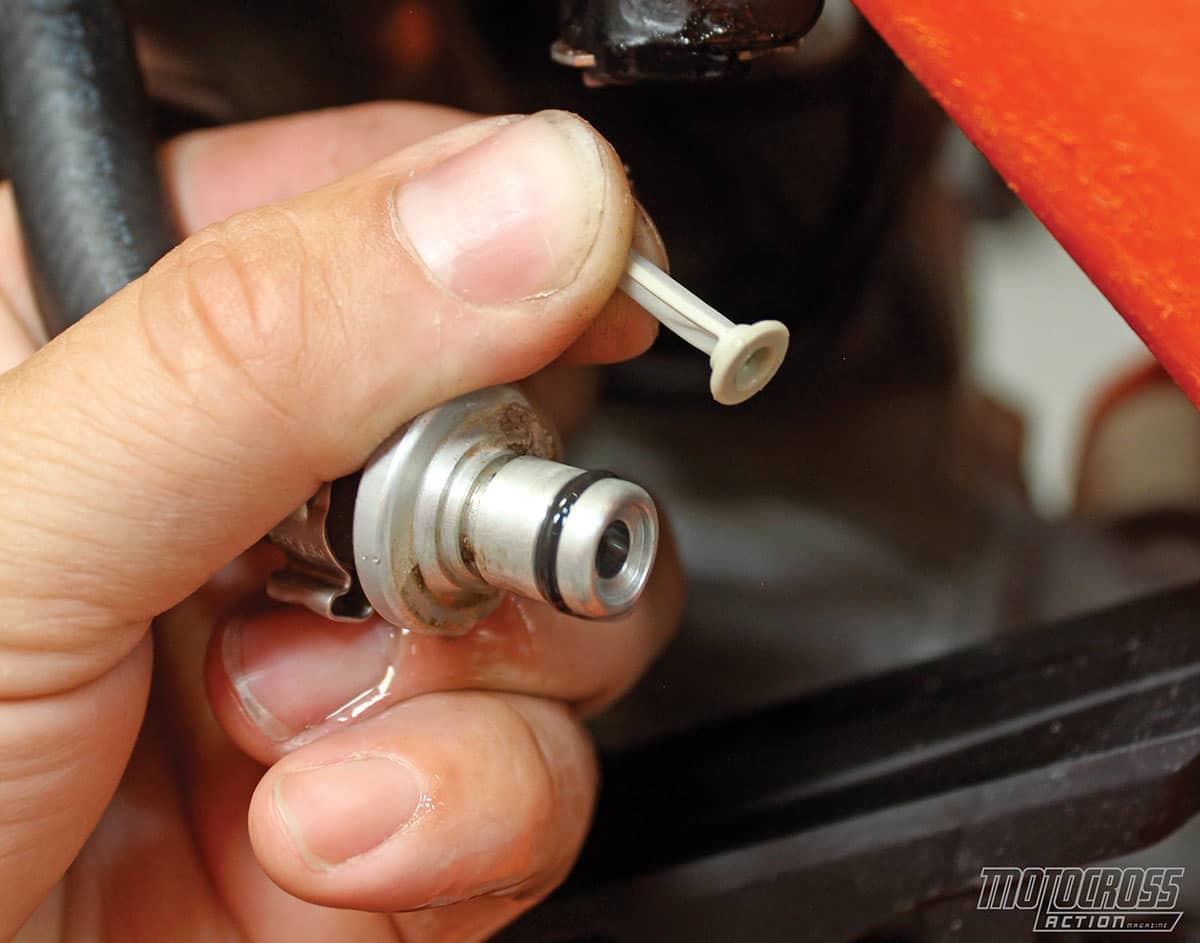
(12) Quick-release fuel lines. The KTM comes with fuel lines that can be disconnected without breaking the steel band that holds other brands’ fuel lines on. And, there is an inline fuel filter that can be removed and replaced in under three minutes.
(13) Plastic frame guards. They keep your boots from rubbing the paint off the side of the frame. Some test riders remove them because they move their feet out a small amount.
(14) AMA/FIM sound-legal muffler. It is quieter than almost any bike on the track.
(15) Chain guide. We put a TM Designworks chain guide on almost every Japanese 450, but not on a KTM.
(16) Wheel spacers. KTM has awesome wheel spacers. Unlike on a lot of motocross bikes, KTM’s wheel spacers run on the bearings, which means that the front and rear wheels can accept different axle sizes just by changing the wheel spacers. This makes older KTM wheels compatible as spare wheels on new-model KTMs (and vice versa).
(17) New shock linkage seal. The rear shock gets new damping characteristics, while the all-new piston damping system improves damping control for better feedback. Plus, the shock gets a more durable O-ring for the internal link piston. Finally, the shock linkage operates on new, low-friction SKF seals for freer movement of the shock linkage. The KTM linkage and Husqvarna FC450 linkages are completely different from each other.

Q: WHAT DID WE HATE?
A: The hate list:
(1) Gas cap. It sticks. Not every time at the track, but too often at the gas station.
(2) Sprocket bolts. Watch them for as long as you own the bike. KTM claims that the sprocket bolts are prone to loosening if the chain is too tight. There is a chain-slack chart printed on the inside of the airbox cover. As a rule of thumb, when the chain looks too loose, that’s when it is correct.
(3) Spokes. Always check the spoke next to the rear rim lock. If it is loose, and five times out of 10 it will be, tighten all the spokes.
(4) Neutral. We love how well the Pankl gearbox shifts from gear to gear but hate how hard it is to get it into neutral when standing still. KTM did this on purpose to eliminate any chance of a rider hitting neutral on the track.
(5) Bike stand. When the bike is sitting on a bike stand, the front wheel is on the ground. This is a hassle when checking the spokes or working on the front end.
(6) Front brake hose. Be very careful when hooking tie-downs onto your handlebars that they don’t crimp the L-bend tube coming out of the front brake’s master cylinder. Always use soft straps.
Q: WHAT DID WE LIKE?
A: The like list:
(1) Everything. You can refer to the “What’s So Great About the KTM 450SXF” section to find out what we liked.
Q: WHAT DO WE REALLY THINK?
A: Don’t buy a 2021 KTM 450SXF if you feel that the Yamaha, Honda, Suzuki or Kawasaki are better. After all, you don’t need the strongest clutch, most powerful brakes, lightest weight, broadest powerband, most accurate handling, braided steel hoses, long- and short-throw throttle cams, easiest-to-use air filter or a Formula 1 transmission.
MXA’S 2021 KTM 450SXF SETUP SPECS
This is how we set up our 2021 KTM 450SXF suspension for racing. We offer it as a guide to help you find your own sweet spot.
WP AER FORK SETTINGS
The 2021 forks have the potential to be great, although most MXA test riders feel that the 2021 Husqvarna forks, which are 10mm shorter, feel better. For hardcore racing, we recommend this fork setup for an average rider on the 2021 KTM 450SXF (stock specs are in parentheses):
Spring rate: 154 psi (Pro), 150 psi (Intermediates), 145 psi (fast Novices), 140 psi (Vets and Novices).
Compression: 20 clicks out (12 clicks out)
Rebound: 15 clicks out (18 clicks out)
Fork-leg height: Third line
Notes: Test riders started with the compression at 12 clicks out and the rebound on 18 clicks out, but went out on the compression and in on the rebound. The 2021 KTM 450SXF comes with rubber rings on each leg to allow the rider to see how much travel he is getting at a given pressure, but the orange rings wear out and slide down by themselves after a couple hours. We got our best feel when the rubber ring was within 1-1/2 inches of bottoming. With that pressure, we could use the compression damping to fine-tune the travel.
WP SHOCK SETTINGS
Most MXA test riders liked the overall feel of the WP rear shock, especially after KTM lowered the shock spring rate in 2017 from 48 N/mm to 45 N/mm. WP did make some technical changes to the 2021 WP XACT shock, but they are mostly focused on a more responsive feel. We run the low-speed compression on 15 clicks out, the high-speed compression 1-1/4 turns out, the rebound on 10 clicks out and set the sag at 105mm. For hardcore racing, we recommend this shock setup for the 2021 KTM 450SXF (stock specs are in parentheses):
Spring rate: 45 N/mm
Race sag: 105mm
Hi-compression: 1-1/4 turns out (1-1/2 turns out stock)
Lo-compression: 15 clicks out
Rebound: 10 clicks out (15 clicks out stock)
Notes: We were rightfully impressed by the shock; however, we turned the high-speed compression damping in a 1/4 turn to lessen G-outs and run more rebound than the recommended setting.


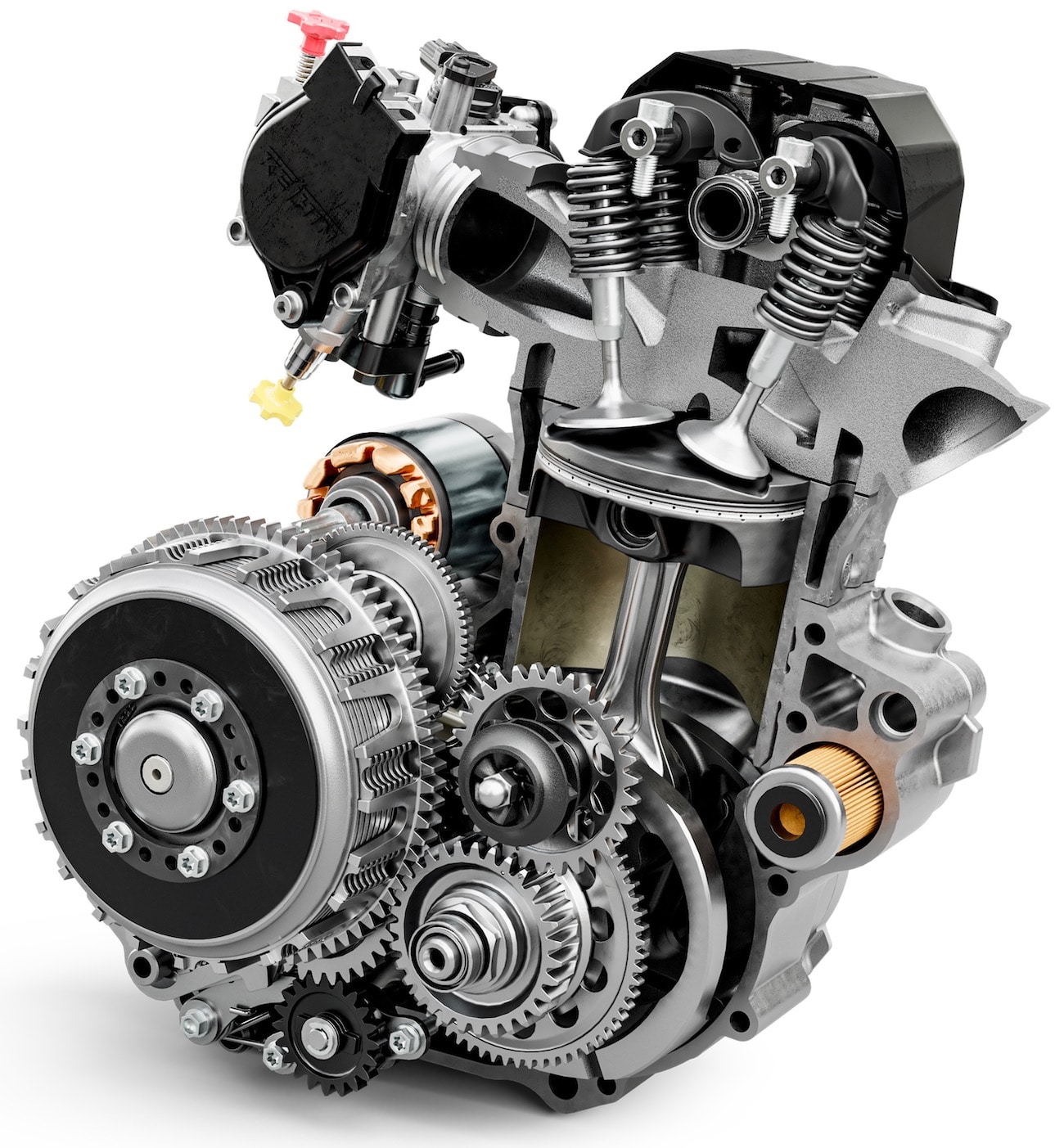

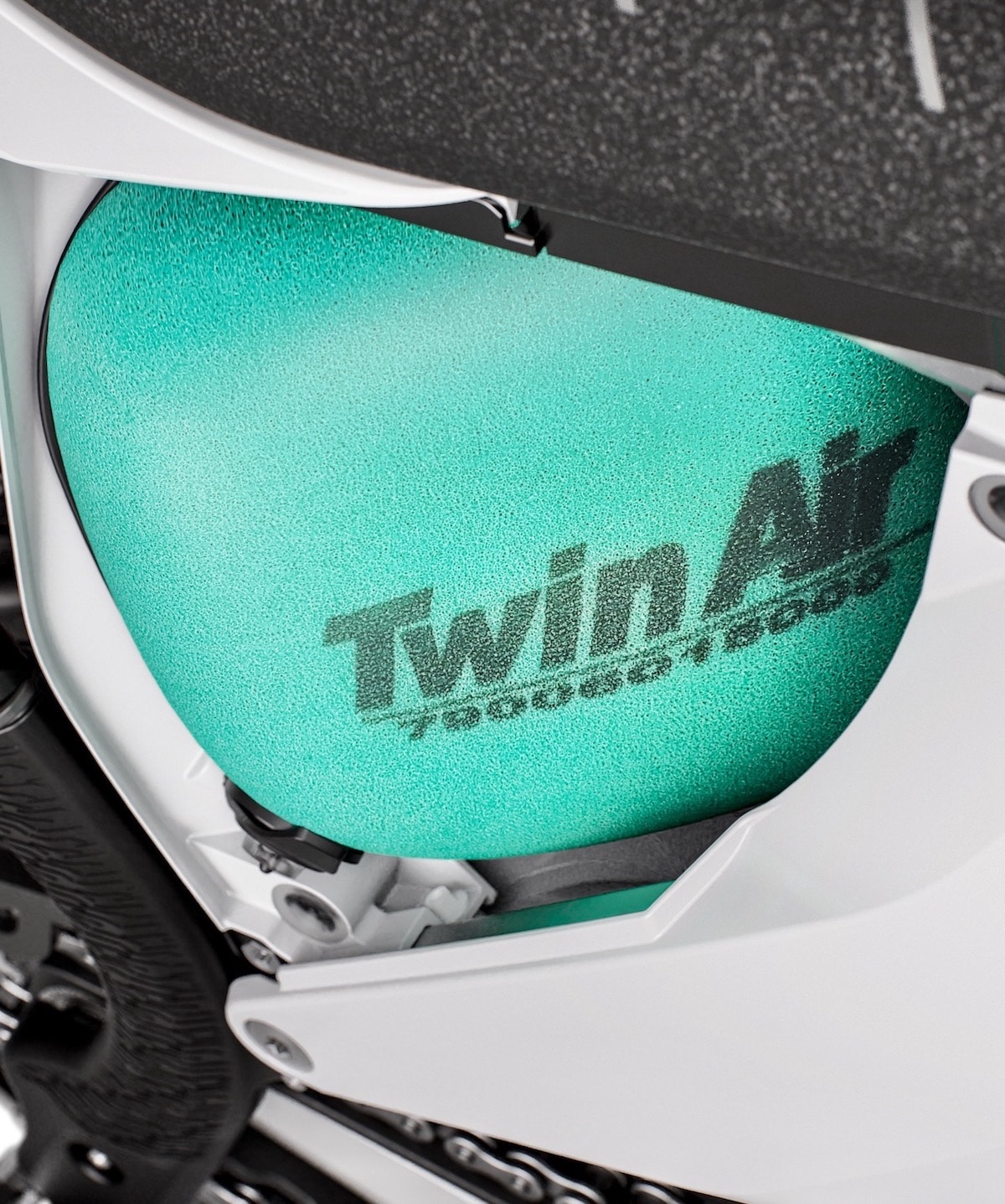
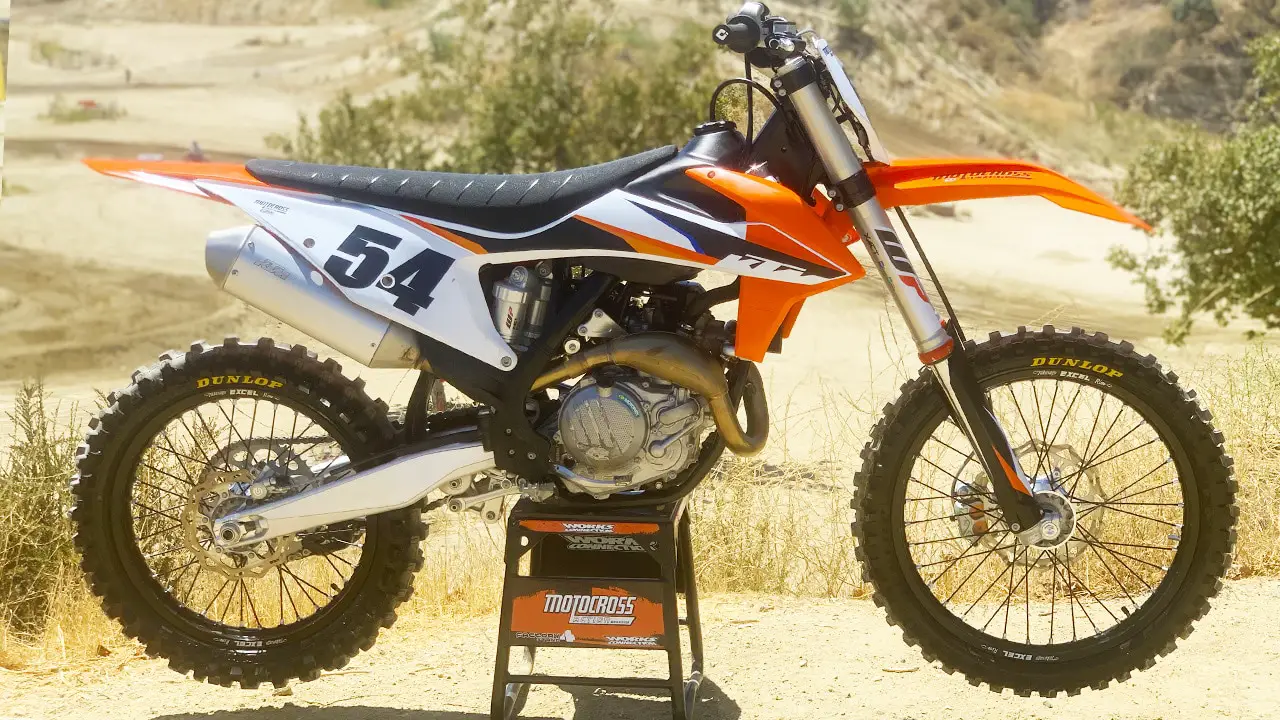



Comments are closed.